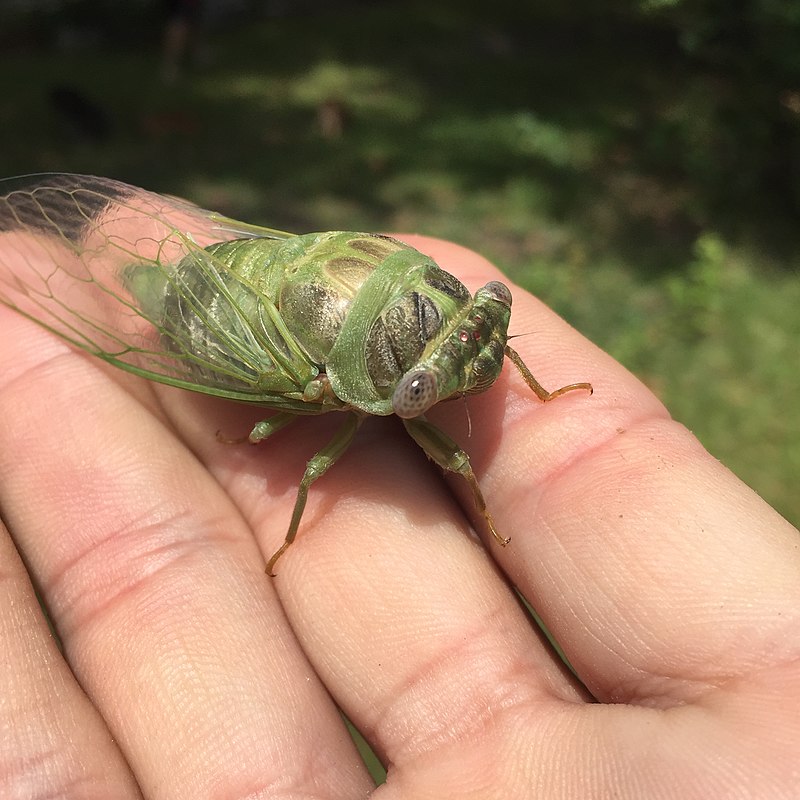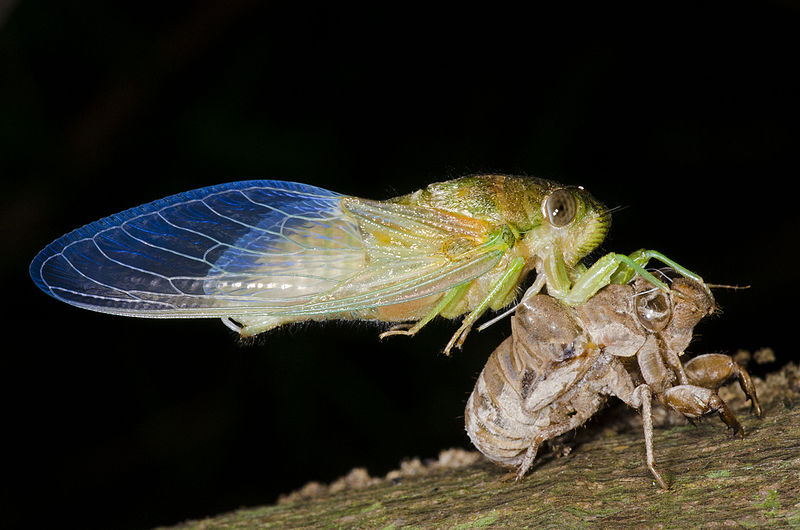The cicadas are a superfamily, the Cicadoidea, of insects in the order Hemiptera (true bugs). They are in the suborder Auchenorrhyncha,[a] along with smaller jumping bugs such as leafhoppers and froghoppers. The superfamily is divided into two families, the Tettigarctidae, with two species in Australia, and the Cicadidae, with more than 3,000 species described from around the world; many species remain undescribed.
Cicadas have prominent eyes set wide apart, short antennae, and membranous front wings. They have an exceptionally loud song, produced in most species by the rapid buckling and unbuckling of drum-like tymbals. The earliest known fossil Cicadomorpha appeared in the Upper Permian period; extant species occur all around the world in temperate to tropical climates. They typically live in trees, feeding on watery sap from xylem tissue, and laying their eggs in a slit in the bark. Most cicadas are cryptic. The vast majority of species are active during the day as adults, with some calling at dawn or dusk. Only a rare few species are known to be nocturnal.
One exclusively North American genus, Magicicada (the periodical cicadas), which spend most of their lives as underground nymphs, emerge in predictable intervals of 13 or 17 years, depending on the species and the location. The unusual duration and synchronization of their emergence may reduce the number of cicadas lost to predation, both by making them a less reliably available prey (so that any predator that evolved to depend on cicadas for sustenance might starve waiting for their emergence), and by emerging in such huge numbers that they will satiate any remaining predators before losing enough of their number to threaten their survival as a species.
The annual cicadas are species that emerge every year. Though these cicadas’ life cycles can vary from 1 to 9 or more years as underground nymphs, their emergence above ground as adults is not synchronized, so some members of each species appear every year.
Cicadas have been featured in literature since the time of Homer’s Iliad and as motifs in art from the Chinese Shang dynasty. They have also been used in myth and folklore as symbols of carefree living and immortality. The cicada is also mentioned in Hesiod’s Shield (ll.393–394), in which it is said to sing when millet first ripens. Cicadas are eaten by humans in various parts of the world, including China, Myanmar, Malaysia, and central Africa.
In some species of cicadas, the males remain in one location and call to attract females. Sometimes, several males aggregate and call in chorus. In other species, the males move from place to place, usually with quieter calls, while searching for females. The Tettigarctidae differ from other cicadas in producing vibrations in the substrate rather than audible sounds.[10] After mating, the female cuts slits into the bark of a twig where she deposits her eggs.[10] Both male and female cicadas die within a few weeks after emerging from the soil. Although they have mouthparts and are able to consume some plant liquids for nutrition, the amount eaten is very small and the insects have a natural adult lifespan of less than two months.
When the eggs hatch, the newly hatched nymphs drop to the ground and burrow. Cicadas live underground as nymphs for most of their lives at depths down to about 2.5 m (8 ft). Nymphs have strong front legs for digging and excavating chambers near to roots, where they feed on xylem sap. In the process, their bodies and interior of the burrow become coated in anal fluids. In wet habitats, larger species construct mud towers above ground to aerate their burrows. In the final nymphal instar, they construct an exit tunnel to the surface and emerge. They then moult (shed their skins) on a nearby plant for the last time, and emerge as adults. The exuviae or abandoned exoskeletons remain, still clinging to the bark of the tree.
Most cicadas go through a life cycle that lasts 2–5 years. Some species have much longer life cycles, such as the North American genus, Magicicada, which has a number of distinct “broods” that go through either a 17-year, or in some parts of the region, a 13-year life cycle. The long life cycles may have developed as a response to predators, such as the cicada killer wasp and praying mantis. A specialist predator with a shorter life cycle of at least two years could not reliably prey upon the cicadas.[53] An alternate hypothesis is that these long life cycles evolved during the ice ages so as to overcome cold spells, and that as species co-emerged and hybridized, they left distinct species that did not hybridize having periods matching prime numbers.
How does the sexually transmitted pathogen affect cicadas?
Well, it’s not very pretty.
The disease acts like a parasite, eating its way through the flying insect’s limbs and other parts of their body. Infected cicadas begin to lose those limbs bit by bit until there’s nothing left.
These “zombies” very quickly become a threat to any and all neighboring cicadas, as males take flight, continuing to spread the fungus around




